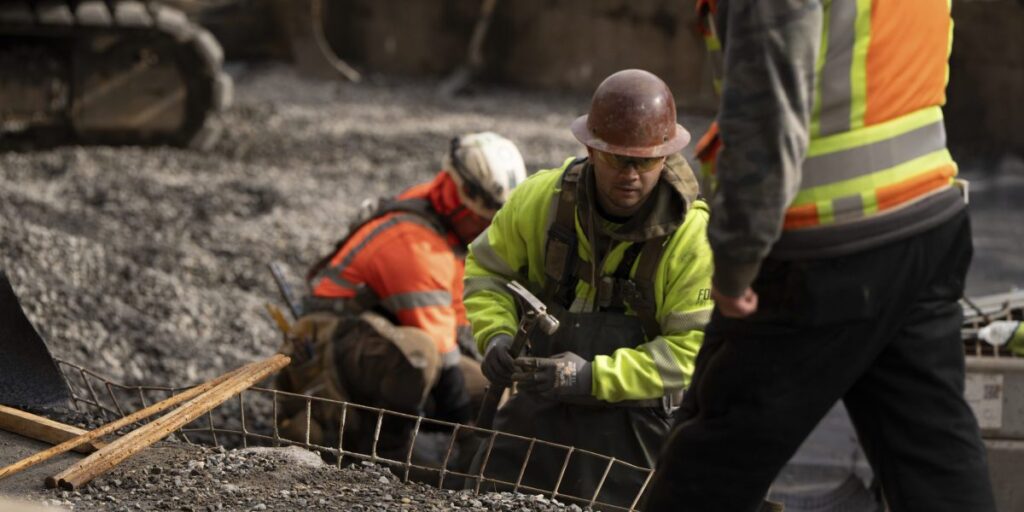
The drilling was out of Timothy Taylor’s house very deep, and he was hearing the lack of cars hitting it from inside his house.
The resident can sympathize with Portland, Oregon, with these drivers: He knew that he would avoid a live hole, but there is one damage to suspend his car at $ 1,000.
“Hearing this terrible sound of your car at the bottom – it is terrible,” he said.
Oregon transport officials say that without further funding, residents such as Taylor can see more declines in road quality, highways and bridges that start this year. However, the revenues resulting from gas taxes that drivers pay in the pump will decrease with the adoption of more people with fuel -saving electric cars, forcing officials to search for new ways to finance the transport infrastructure.
Countries with aggressive climatic targets, such as Oregon, face a mystery: EVS can help reduce emissions In the transportation sector, the country’s largest source of greenhouse gas emissions, but also means less gas tax revenue in government treasures.
“We now find ourselves in a position we want to address fuel use and we offer reliance on gas and internal combustion engines,” Carara Sahr, Director of the Louis & Clark Institute told the law.
Gas tax revenues are to be decreased
Car fuel taxes are the largest source of transportation revenues for the states, according to the National Budget Services AssociationThe latest report on state expenses. But the money they bring has decreased: Gas taxes collected 41 % of transport revenues in the 2016 fiscal year, compared to nearly 36 % in the fiscal year 2024.
In California, where emissions are representedA quarter of car salesLast year,Legislative analysts predictGas tax groups will decrease by $ 5 billion – or 64 % – by 2035, in a scenario where the state meets its climatic goals successfully. California and Oregon are among the multiple states that will require all new passengers that are sold to be zero emission vehicles by 2035.
The trend of revenue is already operated in Pennsylvania, where gas tax revenues decreased by an estimated $ 250 million in the past year compared to 2019, according to the state.Independent financial office.
The inflation also increased the cost of transport materials, which exacerbated the budget fears.
What happens in Oregon?
The Ministry of Transport in Oregon – referring to inflation, projections of low gas tax revenues and some restrictions in spending – a shortage of budget up to $ 350 million for the next budget cycle.
This may mean cuts in snow plowing in the winter, sector and paving roads, as well as hairstyles up to 1,000 transport employees.
Republican lawmakers say that the issue of gas tax revenue has multiplied by the Ministry of Money Administration.ScrutinyIn January, it was found that the administration is exaggerated in estimating its revenues for the current budget course with more than one billion dollars and failed to track some money properly.
“It is really a matter of ensuring that the current dollars spent by the administration spend efficiently and effectively,” said Senator in the state, Bruce Star, Chairman of the Joint Transport Committee of the Republican Party.
How countries enhance transport financing
To compensate for the lost revenues, 34 states of gas tax have been raised since 2013, according to the National Conference of the State Legislative Councils. California has the highest gas tax with more than 69 cents per gallon when it guarantees taxes and other fees, while Alaska has the lowest percentage in 9 cents for gallons, according to US Energy Information Administration figures. In the state of Oregon – which in 1919 became the first state to implement a gas tax – 40 cents per gallon.
The 18 cents federal gas tax, which has not been modified for inflation, has not been raised for more than three decades.
In Oregon, where there is no sales tax andThe fees faced fierce oppositionLong -step legislators discuss the steps.
Other countries have taken steps ranging from gas tax index to inflation to raising the registration fees for EVS, to imposing taxes on EV charging stations.
To support the transportation dollars, some have reorganized their budget“Fix the damned roads,”Some revenues of marijuana taxes and personal income taxes now go to transport. In Connecticut, the sales tax now brings more money to its transport box more than gas tax revenue,The financial report shows 2024.
Another concept that can provide a long -term solution is what is calledRoad user fees. Under such a system, drivers pay fees based on the distance they travel.
In 2023, Hawaii was establishedRoad use fee programFor the EV drivers who will take the stage at the beginning of this July. In 2028, all EV drivers will be automatically registered, with a reading of the high -end scales in the annual vehicles inspection.
Three other states – Oregon, Utta and Virginia – have fees for using voluntary road use. Drivers can choose to use GPS tools to track and report miles.
This story was originally shown on Fortune.com



